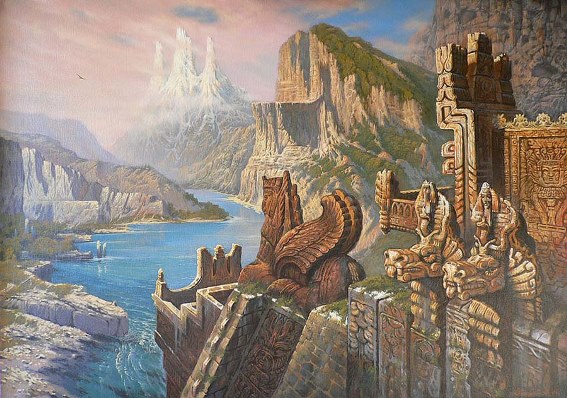Hyperborea fabulous realm

Hyperborea was a fabulous realm of eternal spring located in the far north beyond the home of the north wind. Its people were a blessed, long-lived race untouched by war, hard toil and the ravages of old age and disease.
Hyperborea was usually described as a continent-bound land bordered on the north by the great, earth-encircling river Okeanos (Oceanus), and on the south the peaks of the legendary Rhipaion (Rhipaean) Mountains. Its main river was the Eridanos whose banks were lined with amber-weeping poplar-trees and its waters home to flocks of white swans. Blessed with eternal spring, the land producing two crops of grain per year, but most of the countryside was wild and covered with beautiful forests--the so-called "garden of Apollon."
The southern border of Hyperborea was guarded by the bitterly cold peaks of the impassable Rhipaion (Rhipaean) mountains--home to Boreas (the North Wind) whose chill breath brought winter to the lands of the south. Its peaks were inhabited by gold-guarding Grypes (Griffins) and its valleys by the fierce, one-eyed Arimaspoi tribe. Beneath the southern slopes lay Pterophoros--a desolate, snow-covered land cursed with eternal winter.
Hyperborea was a theocracy ruled by three priests of the god Apollon. These gigantic kings, known as the Boreades, were sons of Boreas (the North Wind). Their capital contained a circular temple dedicated to the god where hecatombs (a hundred-head) of asses were sacrificed in his honour. The people also celebrated their god in an eternal festival of music, song and dance whose hymns were joined by the sweet song of the circling Hyperborean swans.

The realm plays a role in several myths. Phaethon tried to drive the chariot of the sun but lost control and was struck down by Zeus, sending his flaming body plummeting into the Hyperborean river Eridanos. His mourning sisters, the Heliades, were afterwards transformed into amber-shedding poplar trees on its banks, and his grief-stricken friend Kyknos (Cycnus) into a swan. Elderly Hyperboreans commemorated the event by leaping into the lake formed by Phaethon's fall to be transformed into white swans.
Perseus later travelled to Hyperborea and was entertained by its folk when he was searching for the Nymphs who guarded the treasures of the gods, or else the Graiai--swan-bodied hags who could reveal the location of Medousa.
Perseus' descendant Herakles made the same journey on two separate occassions. The first time was in his quest for the golden-horned deer of Artemis which fled north during the chase. The second time he sought Atlas and the golden apples of Hesperides.
Another body of stories describes Hyperboreans as pilgrim-founders of several important Greek shrines. The Delians told a tale of how the pregnant goddess Leto came to the island from Hyperborea accompanied by a pack of wolves where she gave birth to Apollon with the assistance of Eileithyia who was summoned from the northern realm to further the labour. After this event, the Hyperboreans sent pilgrims to the island--five men and several maiden-priestesses. However, after several of the maidens were either raped or killed, the Hyperboreans ended the pilgrimage and instead delivered their offerings indirectly through neighbouring tribes and peoples.
The next major shrine connected with the Hyperboreans was the oracle of Apollon at Delphoi. The second of the early, mythical temples of the shrine was said to have been built by Hyperborean pilgrims out of beeswax and feathers. When the army of the Gauls tried to seize the temple in historical times, phantoms of these prophets were said to have appeared on the battlefield, routing the army.
Finally they appear in the myths of the founding of the Olympic Games. It was said that when Herakles--either the Daktylos or the son of Zeus--established the festival in honour of Zeus he made a pilgrimage to Hyperborea to obtain sacred wild olives for the shrine.
The most famous prophet of the Hyperboreans was probably Abaris who was given a magical arrow by the god Apollon on which he flew around the world performing miracles. Some say this arrow was the one which Apollon had used to slay the Kyklopes (Cyclopes) which had been hidden beneath a Hyperborean mountain.